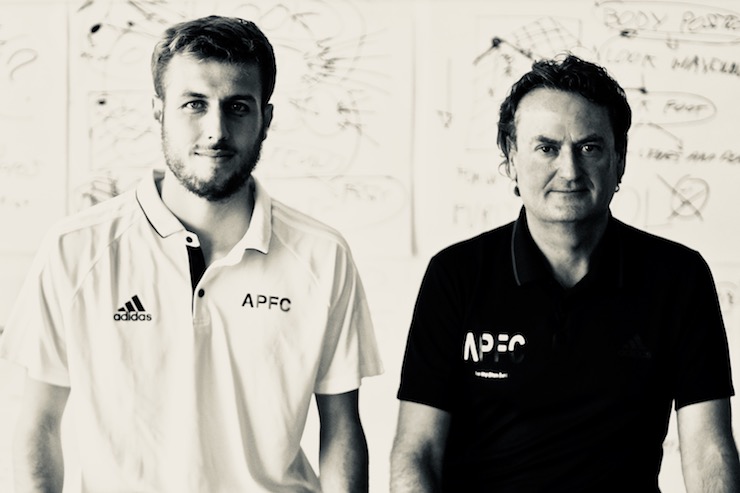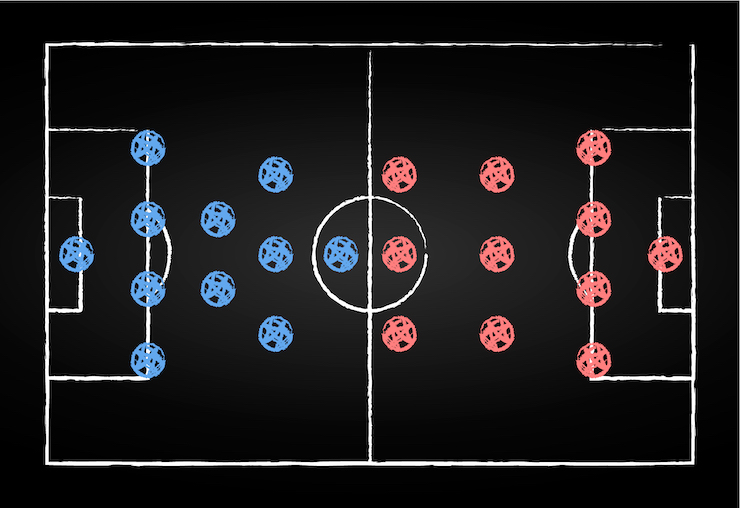Breaking Down The Impact of Positional Play
Albert Puig is a former FC Barcelona Youth Technical Director and now the Assistant Coach of New York City FC. A globally respected leader in player development, Puig’s famed La Masia developed the likes of Andres Iniesta, Gerard Pique, and Lionel Messi. Puig is the founder of APFC Courses – a program to help educate soccer coaches.
This is the first of Albert Puig’s 3 part series in which he breaks down positional play:
Let’s start by once again by restating what the purpose of soccer is … win by scoring more goals than the other team. Otherwise, it’s meaningless. We all understand that in order to win I (my team) needs to score. In order to score, we must shoot on goal and the closer we are to the goal, the higher the chances of scoring.
Now that we’ve oversimplified the game let’s mention the 3 styles of the game:

Direct Using Long Balls
This style of playing uses long balls and highly intense second actions to win the possession of the ball close to the other team’s box. Examples of this could be many English Premier Leagu (EPL) teams in the ’90s and early 2000s (there are many more examples but for simplicity, we will generalize).
Counterattacking Teams
This style is used by teams that prefer to drop back into a structured defensive formation in their own half close to their own goal and when the opposition loses the ball, the team quickly counterattacks in an attempt to score a goal. A current example of this can be Jurgen Klopp’s Liverpool
Positional Style Teams
Teams playing this style move the ball forward one step at a time in search of superiority, with an emphasis on possession, positioning, and passing. This associative style allows the team, the players, the positions and the ball to travel together. Recent examples of this style are Ajax, Barcelona and Manchester City.
Now that we’ve mentioned the styles we need to introduce another concept of the game, which is crucial for understanding the positional play style.
“Building zones” is a key collective concept in any playing style. This concept is the sparkplug by which we move the ball forward, away from our own half of the field and allows us and the ball to move closer into the other team’s box, where our chances to score a goal are high.
Let’s break this down even further.

What Are Zones?
The first and most important thing when talking about building zones is to know precisely what the word zone means in this context.
From a tactical point of view, the field is divided into three different zones.
These tactical zones are of course imaginary and their boundaries relatively flexible but we can nonetheless identify certain areas that allow players to recognize these zones.
Zone 1 – The Build Up Zone
Zone 1 is the third of the pitch which is closest to our own box.
Zone 1 is where we always have more players than the opposing team. The goalkeeper is normally the player that gives our team a numerical advantage (11×10).
Playing formations also contribute to such an advantage. Let’s examine what happens when both teams use a 4-3-3 formation. The other team plays with three forwards (two wingers and one striker), while our team uses a line of four defenders. Therefore in Zone 1, we have a numerical advantage of 4v3 and if we include the goalkeeper, this advantage becomes 5v3.
Zone 2 – Progression Zone
Zone 2 is the area in and around the half line (think ⅔ of the pitch) where there is the highest concentration of players (from both teams), the least amount of space and the greatest amount of pressure. This is normally the battlefield because both teams have the same amount of players.
Playing formations can eventually provide teams with a small numerical advantage. For example, think of two teams playing with two different formations. One team uses a 4-4-2, with two central midfielders while the other team plays in a 4-3-3 formation. This means that the later has three players in the midfield. Eventually, the team with three midfielders will dominate over the team with two. However, the team playing the 4-4-2 formation can have their wide wingers drop inside and play as midfielders and therefore create a numerical superiority of 4v3.
Zone 3 – Finalization/Attacking Zone
We previously stated that the purpose of soccer is to win by scoring more goals than the other team. In order for this to happen, we usually need to reach Zone 3 with the ball under control and having numerical superiority, positional superiority or skill superiority (think Messi in a 1v1) in order to create chances to score.
However, what is Zone 3 for us means it is the other team’s Zone 1 or Defensive Zone.
Thus, the attacking team will initially find itself outnumbered in this zone. The defensive team’s objective in this zone is to protect their own goal by dropping additional players back to populate this zone. This situation inevitably leaves the attacking team outnumbered in this zone (attackers and defenders) which results in it being harder to find a way or space to have a shot on target.

What Do We Mean By A Team Building Through The Zones?
Usually, in Zone 1, the defending team will always have numerical superiority over the other team so we can say that we have a numerical advantage of +1 (removing the goalkeeper from the equation).
As mentioned before, there is usually an equal number of players from both teams in Zone 2. In Zone 3 the attacking team will most likely find itself in numerical inferiority as opposed to the defense.
We can say that the team in possession of the ball has at least a numerical inferiority of -1.
Building zones is a concept that refers to the importance of transferring the numerical advantage we have in Zone 1 (the area near our box) to an equal number situation in Zone 3 (the other team’s box).
Building zones allow the team with the ball to convert Zone 2 into a +1 numerical advantage, which results in Zone 3 being a neutral zone (neither superiority or inferiority).
In other words, building zones can be understood as the way in which teams add players from the build-up zone to the progression zone and from the progression zone to the finalization zone.
What Are The Mechanisms For Building Zones?
An offensive 2v1 enables an attacking team to move players from one zone to the next. This is because a successful offensive 2v1 situation ultimately becomes a 1v0. This means the attacking player continues forward with the ball (unopposed) into the next zone.
If a player from Zone 1 carries the ball forward to Zone 2, the attacking team adds cavalry into the battlefield and eventually starts to increase their numbers or attacking units compared to the numbers of the defending team. If the same process continues into Zone 2 and finally Zone 3, the attacking team should have the same amount of players as the defending team.
By doing so, the chance of finding an offensive 1v1 situation closer to or inside the opposition penalty box has increased.

What If Both Teams Play A 4-3-3 Formation?
In Zone 1 (the build-up zone) there are four defenders (two center backs and two full backs) which are being pressed by three forwards. Therefore, the two center backs have an offensive 2v1 scenario in their favor (versus the striker).
By pushing the two full backs further up on the pitch, this generates more space for the two center backs to successfully win the 2v1 challenge and turn it into a 1v0, where one of the center backs has the chance to dribble the ball forward into Zone 2 (progression zone).
Now let’s imagine that before the ball is brought into Zone 2, the other team decides to start pressing with one additional striker, this turns the situation in Zone 1 into a 4v4 instead of a 4v3. Without yet adding the goalkeeper into the equation, the defensive midfielder (number 6) can drop into the space between the two center backs.
This makes this situation into a 5v4.
The full-backs, by moving forward, have created additional space for the center backs and the defensive midfielder to solve their situation against the two pressing strikers and two wingers. Eventually, the four defenders and the midfielder will seek to turn the 5v4 into a 3v2 which then will be an offensive 2v1 and eventually, the team will convert the numerical superiority into a 1v0 situation where the ball is then carried forward into the next zone.
One final scenario that will help you visualize the concept of building zones is the following: let’s say that the opposing team decides to implement a player on player defending (man-to-man).
If any of the two central midfielders
One of the most effective solutions then is to use the third man concept.
Through third man actions, where players have to deal with equal number situations, we can eventually produce a free man who will carry the ball forward in order to start a new 2v1 situation in Zone 2 (progression zone).

Biulding Zones and Direct Opponents
Building zones is a concept that links playing formations with playing zones (1-2-3) and helps the attacking team to find a way forward. Apart from the information shared above, this concept is also connected to the concept of “Who is My Direct Opponent”.
This is another element to further understand building zones.
If an attacker understands his position and understands and dominates his direct opponent it becomes easier to understand who is the free man. At the end of the day, building zones
How Building Zones is Related to Positional Play
We mentioned that one of the most important, if not the most important, the principle of positional play is superiorities. The purpose of building zones is to achieve that superiority. Thus it is a key part of our style.
“Positional Play is a musical score played by each team who practice it at their own pace, but it is essential to generate superiorities behind each line of the opponent pressure. The team that interpreted Positional Play in a most extraordinary way was the Barcelona of Pep Guardiola.”
– Marti Perarnau
Stay tuned for the second of three parts of the Positional Play series.
Related Soccer News: ALBERT PUIG ON DEVELOPING BETTER YOUTH SOCCER COACHES and ALBERT PUIG ON WHY DO SO MANY YOUTH SOCCER COACHES YELL FROM THE SIDELINES?
Great Read Also: ALBERT PUIG ON THE PROS AND CONS BETWEEN YOUTH SOCCER IN THE USA AND EUROPE





